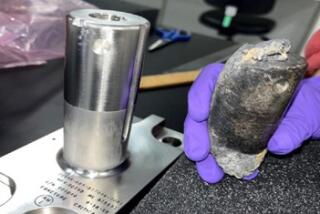Heat Damage Found on Shuttle Wing Section May Be Key Clue
- Share via
HOUSTON — A piece of Columbia’s left wing recovered in East Texas shows significant heat damage and may help prove that superheated gas penetrated the shuttle’s landing gear door and ultimately destroyed the craft, officials said Thursday night.
Sources close to the Columbia Accident Investigation Board, the independent panel appointed by NASA to investigate the loss of the space shuttle, said the wing section -- one of more than 8,000 pieces of debris discovered so far -- is considered particularly significant.
That’s because the section, which is at least 3 feet wide and includes portions of 13 heat-resistant tiles, was from the underside of the left wing, next to the landing gear door. The 300-pound door is considered something of an Achilles’ heel on the space shuttle.
The door is not as strong the rest of the shuttle wing -- for essentially the same reason that it’s easier to kick in a door than to kick a hole in a wall. A particular weak spot is the seam of the landing gear door, and the tiles that showed the heaviest damage on the piece of wing were once located directly next to, and forward of, the hinge of the landing gear door, officials said.
Jeremiah Pearson, the former head of NASA’s space flight program and now the head of an aerospace industry consulting firm, said he has never seen damage like that sustained by the wreckage.
“It seems obvious to me that the landing gear door had to be broken,” Pearson said. He said the damage would likely have caused a significant amount of aerodynamic “drag” that would have overpowered the shuttle’s control system.
Some NASA investigators suspect that debris struck that portion of the craft at some point during the mission -- possibly during liftoff, when foam insulation fell from an external tank and struck the left side of the shuttle, or possibly later in its mission. It’s also possible that a problem originated from within the shuttle and blew a hole in the wing, officials have said.
If the tiles that protect the landing gear door were damaged, some believe the door might have been dented or even fallen off while the shuttle was beginning its descent through the atmosphere. That would have allowed superheated gas, known as plasma, to breach the craft and destroy the critical hardware, including hydraulic systems, stored in the wheel well.
“I wouldn’t call it a conclusive assessment,” said a source close to the investigative panel, who didn’t want to be identified. “But that is our theory.”
The board released Thursday a photograph of the wreckage, which was found within days of the accident. The photo shows a patch of tiles still connected to each other and to a piece of the shuttle’s aluminum shell. It shows significant damage to at least nine tiles, including some that appear to be pocked and others that appear to have melted, apparently while the shuttle encountered temperatures as high as 3,000 degrees while reentering the atmosphere on Feb. 1, officials said.
“Clearly this is not normal,” the source said.
Neither NASA nor the investigative board offered any official interpretation of the photograph.
Analysts also cautioned that some of the damage to the piece of debris could have been caused after the orbiter broke apart and while the debris was falling through the atmosphere.
NASA has not recovered the landing gear door itself.
Several outside engineers and experts, including one with close ties to NASA, agreed Thursday night that the wreckage appears to show the results of an impact near the landing gear door.
“It looks like a strike,” said John Pike, a space expert at GlobalSecurity.org, a Washington research group that focuses on security and aerospace technology issues.
He said the piece of wreckage, discovered in an undisclosed location days after the shuttle disintegrated, could be critical to the investigation. Officials will be able to determine what path the plasma would have taken if it indeed caused the damage to this section of tiles.
“They can stick it into a supercomputer and simulate what gas flow would have produced these results,” he said.
Paul Czysz, professor emeritus of aerospace and mechanical engineering at Saint Louis University and a veteran NASA consultant, said the wreckage appears to support the notion that a portion of the left wing near the landing gear door “really took quite a hit and shattered a lot of the tile.”
“There is a lot of damage,” he said after reviewing the NASA photograph.
Czysz said he has reviewed a video taken by an amateur astronomer in Northern California that shows a piece of debris falling from the shuttle early in its descent. The debris slows down quickly once it falls from the shuttle, which means it was relatively lightweight -- and probably was the landing gear door, Czysz said.
The video, which is being reviewed by NASA but has not been released publicly, also shows a white light on the underbelly of the shuttle.
“That’s nasty,” he said. “You don’t want to see white spots, because that indicates very high temperature. It means something is burning or something is melting.”
Czysz said his calculations show that the door probably landed near the California-Nevada state line.
Investigators have not found debris in that area that they have confirmed as being from the space shuttle.
More to Read
Sign up for Essential California
The most important California stories and recommendations in your inbox every morning.
You may occasionally receive promotional content from the Los Angeles Times.












